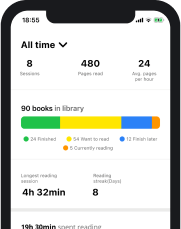Writing a book summary is a great way of extracting the main ideas from a book, is a very effective method of actually understanding in depth what you read and helps you better memorize the information you acquire through reading.
Whether it’s for a school assignment or for your own benefit, being able to write a book summary is an essential part of the reading experience.
Before going into how to write a book summary, let’s make a couple of other clarifications.
What is a Book Summary?
A book summary, as the name suggests, is a summarization of a larger text in a more concise and comprehensible manner. The main ideas of the book are extracted, the main plot and key characters are concisely described and condensed in a short overview.
So what is a summary of a book? It is a writing which, when done well, will allow someone who didn’t read the actual book the summary is written about to feel like they did.
Why Write a Book Summary?
Now that we have a clearer idea about what a summary of a book represents and before going into more detail on how to summarize a book, let’s have a look at why doing this is important and how it can help you.
Here’s a couple of the main reasons why writing a book summary is an important and beneficial task.
1. To Better Memorize What You Read
One of the most important reasons why writing a summary of a book is its role in helping you memorize what you read.
First of all, the simple act of writing down the main ideas from a book or certain essential details greatly increases your chances of remembering them later. This is mainly due to the fact that writing activates certain areas of your brain that reading simply does not. When writing something down, the information goes through a more complex process within your brain and this increases the chances for that particular piece of information to be stored in your long-term memory.
Secondly, knowing that you will need to write a book summary about the book you’re reading will push you to be more involved in reading it. You will pay more attention to the storyline, you will put in more effort in remembering details and characters which in turn will allow you to better understand and memorize what you read.
2. To Exercise Your Summarizing Skills
The ability to identify and extract the key information from a large text is not something we are born with. Summarizing a book is a complex process that requires a certain level of practice, but it has a lot of benefits, especially for young, developing minds.
The act of summarizing a book in itself helps students learn how to discern the key elements from a text, to identify the main ideas and to focus on the important aspects of a book.
Needless to say, learning to write a short summary of a book and actually doing it has a similar effect on all readers, regardless of their age or level of education. The complexity of the process that takes place in our minds while trying to summarize a book is a great training session for our brain, keeping it active, engaged and agile.
3. To Improve Your Writing Skills
By developing your ability to extract important ideas, by increasing your capacity to memorize information and by forcing you to put your own view and thoughts on paper, summaries can help you greatly improve the quality of your writing and your speed.
Mandatory book summaries come with certain instructions or requirements, which help you develop a certain discipline when writing. Plus, we all know that the better you want to be at something, the more you need to practice.
Despite popular beliefs and of course taking the obvious exceptions out of the equation, writing is a skill that is developed throughout a person’s life and has a lot less to do with talent than people are inclined to think. It has more to do with the level of perseverance a person has, the level of practice, discipline and of course, dedication.
By writing book summaries on a regular basis, you gain a better understanding of the books you read, you memorize information quicker and easier, and you practice writing. In time, this will increase your general knowledge, it will help you better structure your own thoughts and put them in a logical and easily comprehensible order and express them in writing.
4. To Complete a School or Book Club Assignment
More often than not, book summaries are mandatory assignments. Whether they are part of the school program or a task from a book club you joined, they are usually the best way a teacher or a book club organizer can make sure that you actually did read the required books.
Especially when it comes to school assignments, summaries are a lot more than just a proof of having read a certain book. They are a great learning tool through which students develop important skills like the ability to analyze literature more in-depth and digest it in a more complex manner than simply going through it and following the storyline.
How to Write a Summary of a Book?
Now that we went over some of the important aspects of book summary writing, let’s get into the most important one: how to write a book summary? Follow our step-by-step tutorial below.
Step 1. Read Carefully, Trying to Understand and Remember the Important Information
As I mentioned earlier, a good place to start your work on the book summary is actually the reading part. Be careful while reading, be involved in the storyline and do your best to understand and remember as much as possible from what you read. That way, when it comes to writing the actual summary of a book, it will be a lot easier for you to condense the information in a top-quality summary.
Step 2. Take Notes While Reading
As much as you will try though, you will probably not be able to remember everything you should, especially if you’re not very experienced with writing book summaries.
That’s why you should always take notes while reading, especially if you’re planning to write about that particular book. Whether you highlight text directly in the book, or write separate notes in a notebook, it is essential that you scribble down the essential information and a couple of details you find important.
While taking notes by hand or highlighting text in the book are viable options, the best way to do this is to use a reading tracking app. Many of them offer quite useful features and can make your life a lot easier.
Basmo, for example, allows its users to take notes while reading. Having your notes in a digital format, in the palm of your hand is obviously a huge benefit. On top of this, Basmo offers many formatting options within the notes-taking section, which will make it incredibly easy for you to organize your ideas and build a structure for your book summary.
To use this feature from Basmo, follow the steps below:
- Open the app and search for the book you need to write about
- Tap on it and start a reading session
- As soon as your reading session begins, you will be able to take notes. Just keep reading and whenever you come across an important piece of information, pick up your phone and start to take notes.
- When you’re finished reading, you can simply end the session and the app will prompt you to add any additional thoughts you left out in your original notes and you can even add details about how you felt while reading certain sections.
When taking notes, you can highlight the important notes with different colors or use Bold or Italic characters to better organize and differentiate your notes. On top of this, Basmo also allows you to scan certain pages of the book and save them for future reference, and it even has a quote saving feature if you want to remember certain key phrases from what you read.
Step 3. Keep a List of All the Characters and Create a Timeline of the Storyline
As you read the book, it’s important to write down all the important characters. Make notes of their names, a couple of their important personality traits and write about the way they influence the storyline.
As the action of the book develops, make sure to write down the main events in the order of their occurrence. You will use this timeline to make sure your book summary contains all the necessary information about the storyline in the correct order.
Again, Basmo can be of great help. By allowing you to make notes and format them according to your preferences and desire, it is a great tool for creating both the list of characters and the timeline of the main events.
Step 4. Divide the Book into Sections and Extract the Main Idea from Each One
It’s also important to try and divide the book into a couple of main sections. The most common way to do this is to identify the introduction, the middle and the ending of the book and to extract the main idea from each one.
Usually the introduction is where the main characters and the premise of the action are presented. The middle section is the part where most of the action takes place and the ending is obviously the part where the storyline comes to a halt and the conclusions are being drawn.
Step 5. Determine the Book’s Main Idea and Several Important Plot Twists
Usually when you’re past the middle of a book, you can already draw pretty accurate conclusions about its main idea. Now is a good time to make a couple of notes about this idea around which the whole book has been written.
If possible, try to also write down a couple of interesting plot points or important events which changed the course of the action in the story. These may be very helpful in determining a couple of the secondary themes in the book.
Step 6. Start Writing the Review Only After You Finish the Book
Taking notes is important, but we cannot stress enough how important it is to never actually start writing your book summary before finishing the whole book. Slowly build your summary’s structure while reading the book, but you should not write the entire summary progressively as you advance with your reading.
When actually writing the summary of a book, follow the steps below:
- Write an introduction. The introduction should not be any longer than a couple of sentences and should always include the name of the book, the author, a couple of words about the main theme and characters.
- Add the important points from the storyline, the important characters and their roles in the story. Once the introduction is done, it is time to start presenting all the important events in chronological order. Include descriptions about the main characters, including important information about their personalities and make sure to mention how their personalities and actions influence the way the story develops.
- Conclude by extracting the main idea of the book and presenting it concisely. Once you’re finished rewriting the story in your own words and describing the characters, it’s time to end the summary with a couple of conclusions. Here is where you should present the main idea of the book and any additional themes that appear throughout the novel.
- Proofread
Once you’ve finished writing and you are happy with the way your summary has turned out, make sure to read it again, looking for any mistakes you could have made. You can also rewrite certain phrases or even paragraphs if you think you can improve them.
What Is the Difference Between a Book Summary and a Book Review?
Since there is a certain level of confusion when it comes to what a book summary is when compared to a book review, here’s a quick explanation.
A summary of a book should be a condensed version of the book, and should contain its main ideas, the subject matter, descriptions of the key characters and a concise description of the action following the same order of the events.
A book review on the other hand is a form of literary criticism, a more subjective description of a book, containing more technical information about the writing style, the author and theme, plus the reviewer’s personal opinion about the book. The action doesn’t need to be presented in the same order as the original book.
How Long Should a Book Summary Be?
While the main rule of thumb to keep in mind when writing a book summary is that your work should be about a third of the original text you are writing about, the length of the summary depends on many other factors.
One of the factors is the actual length of the text you’re summarizing. Obviously, if the non-fiction book you need to write about is 600 pages long, you won’t be able to write a 200 page summary. When this rule cannot be applied, the length of the ideal book summary becomes a fine balance between including all the most important information and getting into too much detail.
Luckily, most mandatory book summaries come with a clear set of instructions, which always include the ideal length. And if it’s not a mandatory book summary, it means you can make your own rules and write as much or as little as you feel necessary.
Conclusion
Writing summaries is an incredibly important part of reading. Whether you do it for yourself in order to enjoy the benefits or you do it to meet the requirements of an assignment, knowing how to do it is a very important skill to have.
There are many benefits you can enjoy when writing summaries, including a better understanding of what you read, remembering more details from the books and a more analytical way of thinking.
And considering how easy apps like Basmo can make things for you, there’s no reason you couldn’t give it a try and include this into your reading routine. Record your reading sessions, take notes while reading, save quotes, follow the instructions in this article and start writing summaries quickly and easily!







